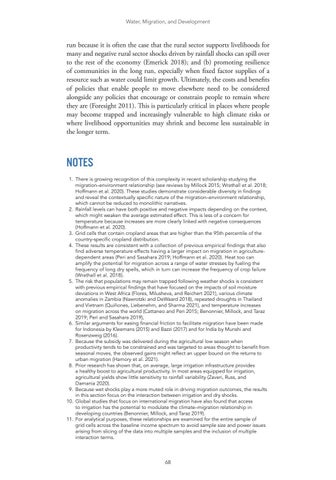Water, Migration, and Development
run because it is often the case that the rural sector supports livelihoods for many and negative rural sector shocks driven by rainfall shocks can spill over to the rest of the economy (Emerick 2018); and (b) promoting resilience of communities in the long run, especially when fixed factor supplies of a resource such as water could limit growth. Ultimately, the costs and benefits of policies that enable people to move elsewhere need to be considered alongside any policies that encourage or constrain people to remain where they are (Foresight 2011). This is particularly critical in places where people may become trapped and increasingly vulnerable to high climate risks or where livelihood opportunities may shrink and become less sustainable in the longer term.
NOTES 1. There is growing recognition of this complexity in recent scholarship studying the migration–environment relationship (see reviews by Millock 2015; Wrathall et al. 2018; Hoffmann et al. 2020). These studies demonstrate considerable diversity in findings and reveal the contextually specific nature of the migration–environment relationship, which cannot be reduced to monolithic narratives. 2. Rainfall levels can have both positive and negative impacts depending on the context, which might weaken the average estimated effect. This is less of a concern for temperature because increases are more clearly linked with negative consequences (Hoffmann et al. 2020). 3. Grid cells that contain cropland areas that are higher than the 95th percentile of the country-specific cropland distribution. 4. These results are consistent with a collection of previous empirical findings that also find adverse temperature effects having a larger impact on migration in agriculturedependent areas (Peri and Sasahara 2019; Hoffmann et al. 2020). Heat too can amplify the potential for migration across a range of water stresses by fueling the frequency of long dry spells, which in turn can increase the frequency of crop failure (Wrathall et al. 2018). 5. The risk that populations may remain trapped following weather shocks is consistent with previous empirical findings that have focused on the impacts of soil moisture deviations in West Africa (Flores, Milusheva, and Reichert 2021), various climate anomalies in Zambia (Nawrotzki and DeWaard 2018), repeated droughts in Thailand and Vietnam (Quiñones, Liebenehm, and Sharma 2021), and temperature increases on migration across the world (Cattaneo and Peri 2015; Benonnier, Millock, and Taraz 2019; Peri and Sasahara 2019), 6. Similar arguments for easing financial friction to facilitate migration have been made for Indonesia by Kleemans (2015) and Bazzi (2017) and for India by Munshi and Rosenzweig (2016). 7. Because the subsidy was delivered during the agricultural low season when productivity tends to be constrained and was targeted to areas thought to benefit from seasonal moves, the observed gains might reflect an upper bound on the returns to urban migration (Hamory et al. 2021). 8. Prior research has shown that, on average, large irrigation infrastructure provides a healthy boost to agricultural productivity. In most areas equipped for irrigation, agricultural yields show little sensitivity to rainfall variability (Zaveri, Russ, and Damania 2020). 9. Because wet shocks play a more muted role in driving migration outcomes, the results in this section focus on the interaction between irrigation and dry shocks. 10. Global studies that focus on international migration have also found that access to irrigation has the potential to modulate the climate–migration relationship in developing countries (Benonnier, Millock, and Taraz 2019). 11. For analytical purposes, these relationships are examined for the entire sample of grid cells across the baseline income spectrum to avoid sample size and power issues arising from slicing of the data into multiple samples and the inclusion of multiple interaction terms.
68



